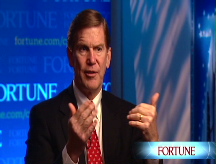Wall Street's red October
This month was one of the worst-ever for stocks. Dow on a wild ride. S&P down 198 points - most ever.
NEW YORK (CNNMoney.com) -- It's finally over.
One of the most stomach-churning and fear-inducing months that stock investors have ever experienced came to a close on Friday.
As of Friday's market close, the S&P 500 had plunged 16.9%, or 198 points, for the month.
That's the worst-ever monthly point decline for the S&P, and it's the eighth-worst percentage decline.
"Unfortunately, the historical precedent here is that we've never seen anything like this in the financial system," said Art Hogan, chief market strategist at Jefferies & Co.
Hogan said this October will be remembered as "stunning on the magnitude of volatility, and the magnitude of market capitalization that was lost."
"October is always the scariest month of the year," said David Wyss, chief economist for Standard & Poor's. "It's when most of the stock market crashes and the bottoms occurred. So it's living up to its reputation. It's going to be a really bad October."
The month looked even scarier at the beginning of the week. As of Monday, the S&P 500 had dropped 285 points for the month. At the time, the index was down 27.2%, which would have been the biggest monthly percentage decline in 57 years and its second-worst performance ever.
Stocks on Friday bounced up and down in early trading. If they had continued to fall, then the month's declines would have rivaled the 21.76 % plunge in October 1987, which included the infamous Black Monday crash of Oct. 19. However, stocks pulled through to end the day higher on Friday.
"At the time, 1987 seemed very bad, a one-day shot that was just so terrible," said Robert Brusca, chief economist at Fact and Opinion Economics. "But it was one day. It turned out to be a great buying opportunity, actually."
On Monday, the S&P's monthly decline had surpassed not only the "Black Monday" month of October, 1987, but it surpassed the second-worst percentage plunge of all time: 25.04% on March 1938. The worst-ever percentage decline happened in the early part of the Great Depression, in September 1931, when the S&P 500 lost 29.94%.
The markets have suffered under the weight of a deteriorating housing market, an ongoing credit crisis, sluggish profits and falling commodity prices. Worst of all, economists say, is that there seems to be no end in sight.
"A combination of negative outlook and uncertainly is toxic for stock markets, and you've got both of those factors on steroids right now," said Jared Bernstein, senior economist with the Economic Policy Institute.
Trading has been extremely volatile, and recessionary fears have spread like a virus, roiling markets around the world.
"The real problem is a total lock-up of the credit markets," said Wyss. "I've never seen that before, just the inability for firms to borrow money."
The Dow Jones industrial average wound up one of its most volatile months ever. The Dow plunged 14.1%, or 1526 points, through Oct. 31.
The Dow has enjoyed only seven positive days in the month, and none of them were consecutive until this Thursday and Friday. The Dow plunged 2,400 points, or 22%, in the week ended Oct. 10. But the Dow also experienced its two best sessions ever: a rise of 936 points, or 11.1%, on Oct. 13, and a jump of 889 points, or 10.9%, on Oct. 28.
The Nasdaq, which consists primarily of tech stocks, plummeted 361 points, or 17.4%, through Oct. 31.
The market malaise is in spite of the U.S. government's sweeping actions to kick-start the economy, including Congressional approval of a $700 billion bailout for Wall Street firms, including buying stakes in ailing banks, and the Federal Reserve agreeing to buy businesses' commercial paper and cutting the federal funds rate by half a point, to 1%.
"This is clearly worse than 1987," said Brusca. "1987 was a one-day wonder. We were shocked, but we recovered quickly from it."
Brusca said that current troubles have more of a pervasive, lasting impact than in the 1980s because more stock is tied up in hedge funds and 401(k) retirement plans. This makes the equities less liquid than day-trader stocks because hedge funds have specific exit rules, and investors are often barred from adjusting their 401(k)s more than quarterly. Also, more people are investing than they were 20 years ago, so stock declines have more of a widespread impact.
Many economists believe the economy is in a recession, while noting that the current problems pale compared to the Great Depression, which began in October 1929.
"1929 was an economic disaster," said Brusca. "In the Depression, remember, one in four people was unemployed."
That's compared to the current nationwide unemployment rate of 6.1%.
Hogan of Jefferies also emphasized that 2008 is a long way from the Dust Bowl days.
"We're not entering a Great Depression," said Hogan. "Hopefully, we've learned how to avoid that."
But as some economists are quick to point out, the current downturn isn't over yet, and no one knows how bad it will be.
"We've got a ways to go," said Wyss. "I don't think it's over. We need to get the election over with. We need to see banks start lending money again." ![]()




